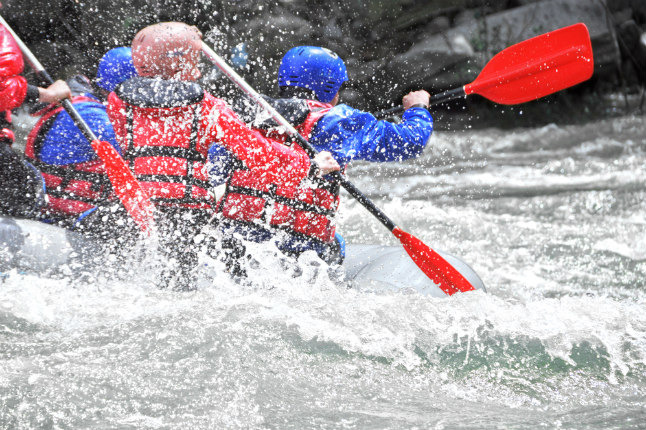Class III Rapids, Fun; Class VI Rapids, Death?
Whitewater rafting—an adrenaline pumping, heart racing good time or a death wish? That all depends on the type of rapids you're paddling in and your skill level. Most people are somewhat familiar with the classes of rapids but few people really know what the different levels mean for their safety.
In short, though it's not an exact science and much of it is subjective, but typically as the numbers get bigger so does the difficulty and danger. Before you dip your paddle in, you should know what's in store. These are the classes defined by the American Whitewater Association, which have since become internationally recognized and used worldwide.
Class I Rapids: Fast moving water with riffles and small waves. There are few obstructions, all obvious and easily missed with little training. Risk to swimmers is slight; self-rescue is easy.
Class II Rapids (Novice): Straightforward rapids with wide, clear channels which are evident without scouting. Occasional maneuvering may be required, but rocks and medium-sized waves are easily missed by trained paddlers. Swimmers are seldom injured and group assistance, while helpful, is seldom needed. Rapids that are at the upper end of this difficulty range are designated "Class II+".
Class III (Intermediate): Rapids with moderate, irregular waves which may be difficult to avoid and which can swamp an open canoe. Paddlers often need to use complex maneuvers and good boat control through tight passages; large waves or strainers may be present but are easily avoided. Strong eddies and powerful current effects can be found, particularly on large-volume rivers. Scouting is advisable for inexperienced parties. Injuries while swimming are rare; self-rescue is usually easy but group assistance may be required to avoid long swims. Rapids that are at the lower or upper end of this difficulty range are designated "Class III-" or "Class III+" respectively.
Class IV (Advanced): Intense, powerful but predictable rapids requiring precise boat handling in turbulent water. Depending on the character of the river, it may feature large, unavoidable waves and holes or constricted passages demanding fast maneuvers under pressure. A fast, reliable eddy turn may be needed to initiate maneuvers, scout rapids, or rest. Rapids may require "must" moves above dangerous hazards. Scouting may be necessary the first time down. Risk of injury to swimmers is moderate to high, and water conditions may make self-rescue difficult. Group assistance for rescue is often essential but requires practiced skills. A strong eskimo roll is highly recommended. Rapids that are at the lower or upper end of this difficulty range are designated "Class IV-" or "Class IV+" respectively.
Class V (Expert): Extremely long, obstructed, or very violent rapids which expose a paddler to added risk. Drops may contain large, unavoidable waves and holes or steep, congested chutes with complex, demanding routes. Rapids may continue for long distances between pools, demanding a high level of fitness and endurance. What eddies exist may be small, turbulent, or difficult to reach. At the high end of the scale, several of these factors may be combined. Scouting is recommended but may be difficult. Swims are dangerous, and rescue is often difficult even for experts. A very reliable eskimo roll, proper equipment, extensive experience, and practiced rescue skills are essential. Because of the large range of difficulty that exists beyond Class IV, Class 5 is an open-ended, multiple-level scale designated by class 5.0, 5.1, 5.2, etc... each of these levels is an order of magnitude more difficult than the last. Example: increasing difficulty from Class 5.0 to Class 5.1 is a similar order of magnitude as increasing from Class IV to Class 5.0.
Class VI (Extreme and Exploratory Rapids): These runs have almost never been attempted and often exemplify the extremes of difficulty, unpredictability and danger. The consequences of errors are very severe and rescue may be impossible. For teams of experts only, at favorable water levels, after close personal inspection and taking all precautions. After a Class VI rapid has been run many times, its rating may be changed to an appropriate Class 5.x rating.
For more information on staying safe in whitewater rapids, visit the American Whitewater website.
